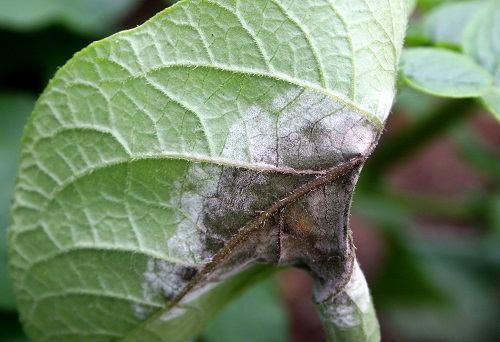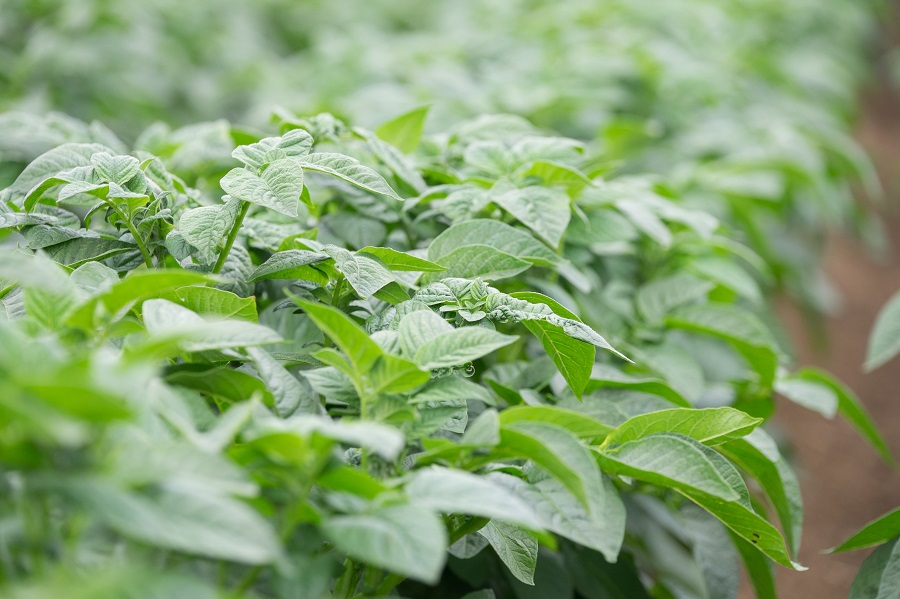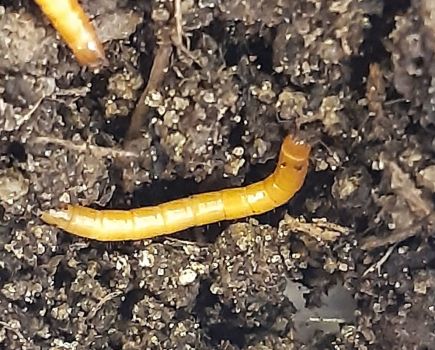The odds of hitting your target go dramatically up when you aim at it and the same could be said to be true when blight spraying. CPM finds out how to set the sights more firmly on preventing the disease.
Even the strongest fungicides can have weak spots due to poor coverage.
By Lucy de la Pasture
The umbrella-like canopy of the potato plant provides a challenge when it comes to applying blight sprays to crops. With good coverage going hand-in-hand with good blight protection, getting adequate chemistry onto the lower leaves is no easy feat.
The changing blight population and increasingly aggressive genotypes make achieving the panacea where blight fungicide is distributed throughout the canopy, even more important, says Stuart Sutherland, Interagro’s technical manager.

The evolution of more aggressive strains of blight requires closer spray intervals, making it more difficult to apply blight products under ideal conditions.
“The newest, highly aggressive blight strains, 37_A2 and 36_A2, join 13_A2 and 6_A1 in being able to rapidly exploit any weaknesses in spray coverage within the canopy. Even the strongest fungicides can have weak spots due to poor coverage,” he says.
As well as being more aggressive, these blight strains appear to be able to produce spores earlier in the season and in greater numbers, which intensifies the pressure potato crops may come under.
One of the biggest problems when applying blight fungicides is to penetrate the canopy so that the lower leaves are protected as well as the upper ones. Failing to do so can result in scattered blight infections which can then spread to form hotspots.
“The potato canopy is made up of interlocking leaves, which are good collectors of vertical moving spray in the upper canopy but the leaves and stems lower down can be very hard to reach.”
Blight sprays can be further compromised by the conditions when they’re applied – something that’s become even more important as blight sprays have to be applied at a seven-day interval, which increases the pressure on spray windows.
Syngenta application trials have shown that even on a perfect spray day, with an average wind speed of 1.2m/s (2.7mph), the actual wind speed can vary from 0.1-4.3m/s (0.22-9.6mph). “Gusts of wind have the potential to leave patches of the crop under-dosed with blight fungicide, which can expose them to a risk of infection,” explains Stuart.
That leaves growers with a bit of a conundrum – do you use a drift-reducing nozzle and produce a larger droplet to keep the spray on target and penetrate the canopy but risk reducing spray distribution on the leaf surface? This is where some clever drift-reduction technology can help growers get the best out of blight sprays, he says.
“Crusade is a special drift retardant that’s been designed to maximise the performance of blight fungicides by removing these physical limitations. It helps maximise fungicide dose and deposition and helps provide full canopy protection by modifying droplet size and distribution.”
By reducing the number of fines (smaller than 100 microns) in the droplet spectrum, Crusade reduces the susceptibility to drift. This effect also increases the spray angle uniformity at the nozzle which helps ensure the correct dose is applied to the leaves, says Stuart.
“Crusade also optimises droplet size in the upper end of the spectrum so that the blight spray is better able to penetrate the canopy and be retained there, which helps improve coverage of the lower leaves and stems and thereby limit the risk of scattered blight infections occurring in the crop.”
Because Crusade modifies droplets at both ends of the spectrum (large and small), it has a beneficial effect with all nozzle types – from flat fans to low drift nozzles.
“It coalesces any ultra-fine droplets, which makes the droplets less prone to drift, and breaks up very coarse droplets into smaller ones, reducing bounce or run-off from the leaves in the canopy,” he explains.
It’s the drift reduction aspect of Crusade that’s of particular interest to Agrii agronomist, Mike Simmons. Many of the potato crops under his care in East Kent are adjacent to vegetable crops, so eliminating the possibility of drift and the potential residue problems that could cause is of paramount importance.
“The more aggressive blight strain 36_A2 is present in my area so we stick to a seven-day interval for blight spraying and that means that sometimes conditions can be less than ideal. Adding Crusade makes it possible to more reliably keep spray intervals on track, while also giving peace of mind that we’re doing the best we can to minimise the risk of drift onto neighbouring crops.”
Mike highlights that the evidence supporting Crusade’s drift reduction capabilities is compelling and that the cost of adding it is minimal for the benefits it brings. “The influence Crusade has on droplet size at both ends of the spectrum helps get the best out of the blight chemistry we have left. Most blight sprays aren’t readily systemic and only a small number of actives truly translocate within the plant, so getting good spray deposition is particularly important during rapid canopy growth and stable canopy,” he adds.
Nick Winmill, Agrii’s technical and development manager for potatoes, points out that a core part of blight strategies has to be resistance management. That involves making use of foliar and tuber blight resistance where the market supports varieties with those traits as well as best use of the blight chemistry available.
“Blight is a dynamic pathogen, so we can’t afford to take our eye off the ball. We already have blight strains with insensitivity to fluazinam and we lost metalaxyl chemistry when 13_A2 came on the scene. That means we have to be on our metal not to allow another genotype to change sensitivity to any more chemistry.”
Nick says the loss of mancozeb would be a blow and the industry is currently waiting for a view from CRD on its future. “In the meantime, mancozeb can still be used and it makes sense to do so to help manage late blight resistance and to control alternaria. With an eye on the future, now is the right time to also have a look at alternatives to mancozeb in programmes.”
Part of resistance management is getting good spray deposition and that’s where Crusade plays an important role, adds Nick. He sees a place for it throughout the programme because of the uplift in fungicide performance that the drift-retardant properties of Crusade bring.
Maximise performance to tackle new blight strains
For the third consecutive year independent blight field trials have shown the performance of Revus (mandipropamid) has been maximised with the addition of Crusade drift retardant technology. The addition of Crusade in the tank-mix with Revus has shown to reduce the risk of drift and therefore improve spray deposition throughout the crop canopy, highlights Syngenta potato marketing manager, Mark Britton.
He explains the Eurofins trials in 2020 were physically inoculated with the more aggressive blight strain 36_A2 for the first time, along with 6_A1, 13_A2 and 37_A2 – representing a broad spectrum of the most common UK blight isolates.
Mark points out that the season-long single product treatment protocol used in the Syngenta trials at Eurofins, involving 11 applications in 2020, was designed to better assess the true intrinsic activity of fungicides, rather than using them in a programme where individual strengths or weaknesses could be masked. It would also better flag up any potential issues of changing product performance to shifting blight populations from season to season, he says.
“Results from 2020 confirmed there were no concerns with the efficacy of Revus against all the blight strains in the test, including 36_A2 which has increased as a percentage of the general late blight population from 2019. Furthermore, when used in combination with Crusade it again consistently achieved better results.”
In untreated plots, blight infection started to take hold towards the end of July and developed very quickly to complete destruction of the green leaf by the third week of August. All the blight fungicides performed well up until early September, when differences clearly started to become apparent.
“Under the trial’s artificially intense blight pressure, Revus plus Crusade gave the stand-out result of the fungicides tested, keeping blight at the lowest level in the trial plots,” he comments.
With the nozzles used for the Eurofins trials being quite drifty, Mark believes the addition of Crusade is helping to get more fungicide into the canopy and working more effectively.
Using an assessment of AUDPC (Area Under the Disease Progression Curve) gives the best picture of season-long product performance, he says, and here Revus plus Crusade clearly shows the lowest infection of all the products on trial. That very much confirmed the results seen in the intrinsic activity trial run in 2019, he adds.
3D Ninety keeps application on target
The Eurofins trials in 2020 also demonstrated results of Revus applied through the new drift reduction nozzle technology from Syngenta, 3D Ninety. This was still further enhanced with the inclusion of Crusade, albeit by a lesser amount than with more drifty conventional potato nozzles.
Syngenta new farming technologies lead, Harry Fordham, says the 3D Ninety nozzle’s 55° angle has shown to get more even blight protection/spray distribution throughout the crop canopy.
“The inherent drift reduction from the design of the 3D Ninety minimises any impact of sideways spray movement, to achieve consistent distribution across the boom. The nozzle produces a spray pattern less affected by boom height – to give better distribution through the potato crop canopy,” he explains.
“When used for Revus application in conjunction with Crusade, it proved to give the best and most reliable results in nozzle trials at Eurofins last season.”
Harry highlights the team had used glow-in-the-dark UV tracer dye to reveal precisely where application droplets were reaching in the Eurofins trials.
“Results showed that with a standard potato nozzle, producing mostly fine droplets with low kinetic energy, the majority of the product is held on the growing point and top leaves of the canopy.
“When the Crusade drift retardant is added, we get more larger droplets which are better able to reach down to the middle and bottom leaves of the canopy. The coverage and retention on the upper leaves is still very good, but there’s additional benefit down to the lower leaves.
“Analysis of the droplet spectrum has shown that the Crusade takes out the really small and most drift-susceptible fine droplets, so it’s making the nozzle less drifty and ensuring we get more product on the crop.”
When applying Revus alone with the 3D Ninety, the nozzle provided far more consistent coverage of product, deeper into the crop canopy and evenly across top and middle leaves, says Harry.
“When the Crusade was added into the mix, the coverage on the leaf surface is further enhanced, but also with more product getting down to the lower leaves.”
Translating this into results in the field in the blight fungicide trials, it shows all the nozzles performed better with the Crusade in mix with Revus. The greatest improvements were seen from the more drifty nozzles, such as the flat fan and standard potato nozzle, but even with the new drift reduction technology there were still valuable additional benefits from Crusade’s inclusion.
The 3D Ninety when fitted to alternate the spray pattern forwards and rearwards along the spray boom, improves efficacy, increases work rate to take advantage of any spray opportunities and reduces drift – which is good for the environment and getting the best value from every application, comments Harry.
“With the Syngenta Potato Nozzle being withdrawn from manufacture, the 3D Ninety will be the nozzle of choice for potato applications when it’s launched later this year,” he believes.
The recommended water volume of 200 l/ha for both pre-emergence applications and blight sprays remains best practice in most situations, including treatments with Crusade on the blight spray mix.
Pushing performance
At the heart of good crop production lies careful use of chemistry to protect the plant and maintain performance, right through the season. But optimising the efficacy of plant protection products can be challenging, while increasingly restrictive regulations limit just how far you can go.
This series of articles explores the science behind the use of adjuvant and biostimulant tools to help power both chemistry and crop performance, as well as increase understanding of why they’re needed and what they do. We’re setting out to empower growers and drive crops to reach their full potential.
CPM would like to thank Interagro for kindly sponsoring this article, and for providing privileged access to staff and material used to help put the article together.
Crusade is a flexible anti-drift agent to maximise protection and prevent blight infection. For use with all potato blight fungicides throughout the programme, Crusade is designed to reduce spray drift and maximise coverage to all parts of the canopy, so you get the most from your spray and keep blight away.




